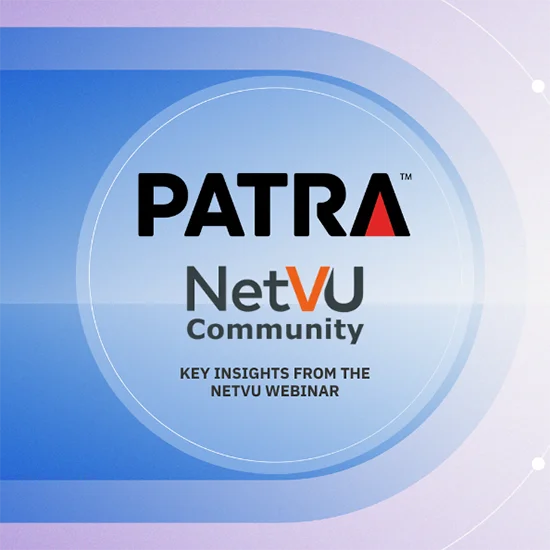Real AI for insurance: Key insights from the NetVU webinar
On September 25, 2025, Patra hosted a webinar for the NetVU community exploring real AI solutions for insurance operations. The session, “Beyond the Buzz: Real AI Solutions for Insurance Operations,” drew hundreds of insurance professionals including agency owners, account managers, and operations leaders. They all grapple with the same fundamental question: How do we move from AI hype to actual operational value?
The polling results revealed something striking: 50% of agencies are already using some form of AI, while another 41% are actively researching solutions for 2025. That’s 91% of the insurance community either implementing or seriously evaluating AI technology right now.
But perhaps more telling was the second poll question about operational backlogs. When asked which processes create the biggest bottlenecks, 52% pointed to policy checking, the time-intensive, document-heavy work that can consume 60-90 minutes per policy and often gets skipped entirely for lower-premium accounts.
The connection between these two data points tells the real story of AI adoption in insurance: agencies aren’t chasing technology for its own sake. They’re looking for solutions to specific, costly operational problems that manual processes can no longer handle at scale.
The industry reality check: What the data really means
When half of insurance agencies say they’re “already using AI,” what does that mean? The reality is nuanced. Many agencies are using basic tools such as OCR document scanning, simple data extraction, rule-based automation and calling it AI. While these tools provide value, they’re often at the foundation level of what AI can accomplish for insurance operations.
The 41% who are “researching in 2025” represent a more sophisticated cohort. These agencies have seen the limitations of basic automation and are looking for solutions that can handle the complexity and variability of insurance documents. They’re asking harder questions: How accurate is it? What kind of oversight is needed? Can it handle non-standard forms and endorsements? What’s the actual ROI?
The remaining 9% planning for 2026 isn’t necessarily behind, they may be taking a strategic approach, watching early adopters and learning from their experiences before committing resources.
The policy checking crisis that is hindering your account managers
The 52% citing policy checking as their biggest backlog isn't surprising to anyone working in agency operations. Policy checking is the perfect storm of operational challenges:
Time-intensive:
A thorough policy check requires 60-90 minutes of focused workDetail-oriented:
Small errors can lead to significant E&O exposureHigh-volume:
Agencies managing thousands of policies face an impossible workloadLow-premium problem:
Many agencies skip checking lower-premium policies entirely because the cost doesn't justify the time
The result? Either agencies invest in additional headcount (increasingly difficult in today’s tight labor market), accept E&O risk by skipping checks, or watch service quality decline as staff rushes through reviews.
Quote comparisons (19%), coverage gap analysis (16%), and contract review/compliance (13%) round out the backlog challenges, each representing document-heavy processes that consume valuable time that could be spent on client-facing work.
Understanding the AI evolution: Where does your agency really stand?
Not all AI solutions are created equally, and understanding the evolution of AI adoption in insurance helps agencies evaluate what they need versus what vendors are selling.
- Foundation: Intelligent data extraction
This is where most agencies currently operate. These solutions use OCR, rule-based logic, and early-stage machine learning to extract data from insurance documents. They’re helpful for basic data entry tasks but have significant limitations:
- Heavily reliant on traditional programming techniques
- Not reliable without extensive human review
- Struggle with document variation and non-standard forms
- Can’t handle complex, document-centric processes end-to-end
If you’re using a tool that requires significant manual cleanup or frequent error correction, you’re likely at this foundation stage.
- Present: AI-centric workflows (the current sweet spot)
This is where real operational transformation happens. AI-centric workflows combine advanced AI models, including Large Language Models (LLMs), with structured human oversight to process and analyze unstructured insurance documents.
Key characteristics:
- Adapts to different document types and formats
- Can handle complex policy documents with high accuracy
- Still requires human oversight for validation and quality control
- Suitable for complete, document-centric processes with defined workflows
This level delivers measurable ROI because it addresses the full workflow, not just isolated data extraction tasks. For policy checking, this means reducing a 60–90-minute manual process to 5-10 minutes of AI-assisted work with human-in-the-loop verification, maintaining 100% accuracy while dramatically reducing time investment.
- Research: Guided agents (pre-production stage)
The next evolution involves agent frameworks with defined guardrails that allow AI to make tactical decisions within constrained problem spaces. These systems can:
- Detect document types and adjust processing paths accordingly
- Make quality assessments and route work appropriately
- Handle dynamic workflows based on document characteristics
This technology exists in research environments and early production pilots, but it’s not yet widely available or proven at scale. Agencies evaluating solutions in this category should ask tough questions about production readiness and real-world validation.
- Future: Autonomous agents will drive AI adoption in insurance
Fully autonomous systems that can handle complex, undefined tasks dynamically, including transacting with legacy systems and adapting workflows based on context, remain in the research phase. While exciting, these solutions aren’t currently feasible without further advancements in AI reliability and trust mechanisms.
The bottom line for agencies: The gap between “foundation” and “present” represents the difference between marginal efficiency gains and true operational transformation. If you’re in the 50% already using AI but not seeing dramatic results, you may be working with foundation-level tools when AI-centric workflows could deliver significantly more value.

Want to continue the conversation?
Patra's AI-powered solutions for policy checking, quote comparison, and policy data extraction are helping agencies across the NetVU community address their biggest operational backlogs.
About Patra
Patra is a leading provider of technology-enabled insurance outsourcing services and AI-powered software solutions. Patra powers insurance processes by optimizing the application of people and technology, supporting insurance organizations as they sell, deliver, and manage policies and customers through our PatraOne platform. Patra’s global team of over 6,500 process executives in geopolitically stable and democratic countries that protect data allows agencies, MGAs, wholesalers, and carriers to capture the Patra Advantage – profitable growth and organizational value.

